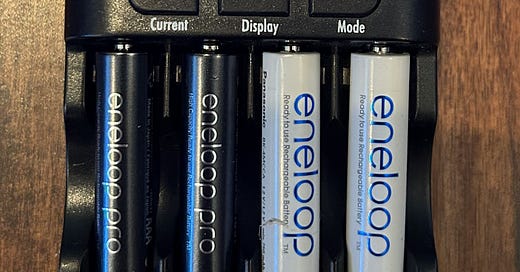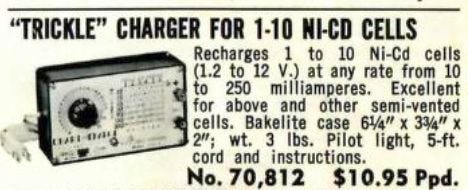Recharging “things” has become a new part of the daily routine for us. To be fair, recharging has come a long way from when it was still optional to now, essentially required. And I’m not even talking about your electric scooter/bike/car!
I remember making sure the 4 NiCad AA cells were topped up on the wall charger so I could listen to a Vangelis mix tape on my Walkman while doing yardwork for the neighbor.
Where We Started
Yep, nearly $4/lb. and you better know how to set it and not fry your battery pack. Obviously things have improved today to make it simpler. So let’s get started.
Normal AAA and AA Rechargeable Cells
Far and away these are the batteries you use most. NiCad cells are out, the future is nickel metal hydride or NiMH and Eneloop brand are, in my experience, the best. Panasonic now owns them so you can rely on the excellence of Japanese quality control as well.
Shown above are the older white ones and the new Pro model (black) in a charger. Capacities are:
Type and size Capacity, mAh
AAA 750
Pro AAA 930
AA 1,900
Pro AA 2,500Their current chemistry yields over 2,000 cycles as well. That’s impressive and quite a long way from Li-Ion tech which is maybe 400 cycles if you run between 20% and 80% state of charge.
Unfortunately you’re still stuck at 1.2V output on these cells so they can fall short on some devices where a 1.5V alkaline makes the difference because the circuit was designed for that (like backpacking headlamps and some remote controls). You can practically buy these at 7-11 so there is no point in linking to vendors.
And if you have the funds there is also no point in not springing for the Pro cells since they both weigh the same.
My preferred chargers are the Powerline series from Ansmann since they are intelligent, offer up statistics and the more advanced ones can bring totally discharged cells back up to life (if they are not irreversibly damaged). There are AA-sized adapters you can snap in to recharge C and D sized cells, too - which I use on my game camera and fuel transfer pump.
Powerline chargers also run on a 12VDC input which is great for car and solar use. AND they provide a 1A USB output (when not charging cells) which can really be convenient as you’ll see later. Again, they are available just about everywhere.
Part 3 will cover the “less normal” AA cells which have found a place in the array of my reliance system.




